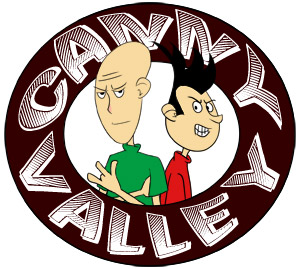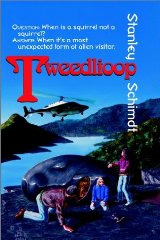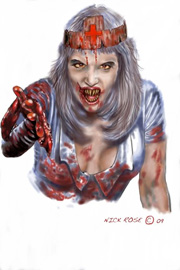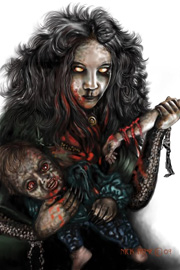written by Frank Dutkiewicz
Whew. A lot going on in our little Diabolical world. So much David Steffen has left the substitute in charge. David assures me that Anthony Sullivan is more than capable for the job, and said he has yet to miss an edit.
On to this month’s review!
A little girl has a gift the alien overseers need in “Substitutes” by Colin P. Davies (debut 2/1 and reviewed by Frank D). Melinda has been blessed with the ‘gift’, the ability to navigate the stars. Aliens have come to Earth and spread a condition among its youth. Melinda’s father calls it a disease, but for the few who have been affected, they are prized by the aliens. They offer compensation to Melinda’s father, and a substitute that is in every way a perfect copy of Melinda. It isn’t enough for Melinda’s dad, but the aliens are relentless. The pair have been playing a cat and mouse game as they try to stay a step ahead of the aliens, but the creatures who have managed to travel the stars are far too clever to shake.
“Substitutes” is an eerie tale. Whatever the affliction Melinda is under, it has affected her mental capacities. Her father reacts how I’d imagine most people would react, angrily and fearfully. The brief tales plays out like a Stephen King premise, clones stalk the pair as they run to new homes. An increasingly desperate father gets more violent with every encounter.
I really liked this story. Liked it so much I was disappointed that it ended so quickly. Add 80,000 words as good as these 2000 and it would make a great novel.
Recommended.
An abandoned and hungry girl stumbles upon an edible house with her brother. “Hungry” by Robert E. Stutts (debut 2/4 and reviewed by Frank D). The protagonist is a captive in a cannibalistic witches’ home. The witch has imprisoned her brother in a cage and is fattening him up while impressing the little girl to be her apprentice. The little girl knows this will not end well for her and her brother, no matter how much the outcome changes.
Mr Stutts R rated version of ‘Hansel and Gretel’ is dark, even for this very grim Grimm tale. I found myself glued to it, as if I had fallen under a spell. Daily SF has published many disturbing tales. There may be a creepier tale than “Hungry” in its archives but if there is, it isn’t coming to mind.
The need to belong compete with its consequences in “Wildness and Wet” by Lee Hallison (debut 2/5 and reviewed by Frank D). Leah watches a flash dance performance from the safety of her bedroom window. The dancers are teenagers her age, connected via implants to the web. They share a clique like no other in history. Leah wants to be a part of it, and the boy who climbs to her open window may be too alluring to resist.
“Wildness and Wet” is a tale of temptation. The kids joined in this futuristic web have a shared physic ability thanks to the enhance technology. They garner all the substance they need through the implant and share a closeness ordinary human contact can never achieve, but their candle burns twice as quick and they die very young , burned out expending the extra flare they have enjoyed. Leah is like an imprisoned princess , unable to be a part of the exciting world she sees but she is very aware of the price she would have to pay to be a part of it.
I have one major complaint about this story , way too brief. This is just a taste of a far larger idea. I hope Ms Hallison explores this world further and shares her findings with us in the future.
A scientist and his greedy sister fight over their departed father’s possessions in “Mirror Image” by Peter M. Wood (debut 2/6 and reviewed by Frank D). Sam is a physicist but even he can’t piece together what his extrinsic father’s basement lab is all about. Doris, his sister, wants to sell it all and split the sale 50/50. She had already bilked Dad of the rest of his assets but it is never enough for her. Sam wants to see if there is anything to his late father’s claims of alternate realities, but Doris’s greed may make it all a moot point.
This tale explores the insanity of adults who fight over their departed parents belongings and adds a convenient twist to it. Amusing, in this world and in the one next door, I’m sure.
The “Time Travel Device” by James Van Pelt (debut 2/7 and reviewed by Frank D). The protagonist has created a means to travel through time. He isn’t able to control where he goes, his own desires choses his destination for him. Where you go can say much about the person you are.
This short tale has a morbid tone to it. Fascinating destinations, but I’d be worried if I were the protag.
A socially awkward girl makes her pitch for a date in “A Phone, My Heart, and Maybe My Last Shred of Dignity” by Luc Reid (debut 2/8 and reviewed by Frank D). Iowa is a loner in a society where no one is alone. Her life is a series of disasters. Today has been an unusually brutal day even for her, but reflection can help heal her self-inflicted wounds.
“A Phone” is a comedy of errors with a love story buried within. The story is told in a string of flashbacks , unusual but effective when written by someone as skilled as Mr Reid. Iowa has fallen for a woman giving a demonstration at 20th century fair. Iowa hatches a very crazy plan in hopes of impressing her.
I simply loved this tale. The ending of it was the beginning; watching Iowa’s crazy plan unravel in reverse made it that much more entertaining. You may need to jump back to the opening to notice the sweet conclusion to the story.
Recommended.
Charles Milford speaks for the President in “For The People” by Ronald D. Ferguson (debut 2/11 and reviewed by James Hanzelka). He has no official title, no position, but he sees him every day; which makes him the perfect vessel for the explosives planted in his abdomen. The resistance movement plans on using the drugged Milford to kill both the President and the Vice President. But will the plan succeed or do the rebels have it all wrong?
This story was set in the not too distant future, maybe one we can even see from here. I thought it was a little uneven at the beginning; but as I read on, I was rewarded with a pretty good story. It had a nice little twist at the end, and I’m a sucker for those, so maybe I’m prejudiced, but I thought it worked well. I think if you keep an open mind at the start of the story, it’s worth it in the end.
Kane is an empathy in “The Needs Of Hollow Men” by K.A. Rundell (debut 2/12 and reviewed by James Hanzelka), one that works for the police to solve crimes from the emotions left behind at the scene. A “hollow man”, someone empty of his own emotion. His lack of personal emotions facilitates his work, of course the meds help. But Kane is a man in trouble; the emptiness has been filled by everyone else’s emotion, squeezing him from inside. Who can help ease the pain he feels? Who will help the needs of a hollow man?
This story is well laid out and does a good job of ushering us into Kane’s world. We also get to see how he is starting to unravel. I think the author did a nice job of striking the right balance of information about Kane and the emotion he is dealing with. Nice story.
Recommended.
Two fairy tales intertwine in “A Hairy Predicament” by Melissa Mead (debut 2/13 and reviewed by Frank D). Mother Gothel has taken Rapunzel of her overwhelmed parent’s hands. Disposing her abundant hair has proven problematic but Rapunzel has an idea. Mother Gothel knows a Fae spell has its consequences, and a grieving widowed giant has come to complain.
This dark fairy tale is written with a tongue in cheek. Cute.
A little girl draws maps of the future in “Maps” by Beth Cato (debut 2/14 and reviewed by Frank D). Christina is cursed with the ability to predict the tragic future. Her left hand independently pinpoints the place where future events will happen. It is a gift she does not want and she is willing to maim herself to rid herself of the curse.
“Maps” may be the most tragic story I have ever read on DSF (quite a claim for this publication). The story was like watching an accident on the side of the freeway, I couldn’t tear my eyes away. High marks to Ms Cato for her accomplishment.
A creepy guy offers to buy a woman a drink in “Five Minutes” by Conor Powers-Smith (debut 2/15 and reviewed by Frank D). Sasha is a hard working single mother; stopping at a local pub for a quick drink when a man takes the stool next to her. She needs to get home to her sleeping children but the man is insistent that she wait and listen to him. The strange man claims he has a limited gift of foresight. He only can see five minutes into the future, an ability that hasn’t been all that beneficial for him. Sasha can’t get away from him quick enough but he only wishes for two minutes of her time, offering to sit with her on the deck and watch as the cars pass through the nearby intersection.
“Five Minutes” is told from the perspective from an exhausted woman. That last thing she needs is to placate a disturbed man. It is written as if you are sure this man is up to something sinister; expecting a dark turn of events to spring into action as you read. Well done.
If you were to take the title and the strange man’s backstory into account alone, you would likely be sure how this tale would conclude. It takes a skilled writer to lead the reader into a different direction. Mr Smith’s use of characters and a careful crafting of the tone of the story will make you doubt the obvious.
Recommended.
The world is ending and there is only one place you can go to be saved in “The Mountain” by Andrew Kozma (debut 2/18 and reviewed by Frank D). Salvation from annihilation can be found on a series of hills with very descriptive (and bland) names. The people count their numbers (only a few can be saved) and watch as the universe dissolves.
“The Mountain” is told from a distance and with little emotional flare. The faceless characters of the story are rescued but have nothing left. I failed to see the point of any of it.
A fatigued man frightens an imprisoned woman in “Coffee Pot” by Jez Patterson (debut 2/19 and reviewed by Frank D). The protagonist is huddled in a bed, watching a man who sips coffee. She just wants him to fall asleep so she can escape. Escape has its permanent drawbacks, in her case.
I hesitate revealing anymore to this tale. Suffice to say it has an effective twist. Unfortunately, the storyline didn’t capture my interest that much.
“I Heard You Got a Cat, I Heard You Named Him Charles” by M. Bennardo (debut 2/20 and reviewed by Frank D). The protagonist has heard his old girl friend has gotten a new pet. It was unnecessary, because he could have taken the position of a cat for her. He could be anything she wanted, and had never left her side.
This story is told from the perspective of a shape changing stalker. He is willing to do anything for her just so he can stay by her side. He is the ultimate in creepy behavior. I really felt for his girl.
Fulfilling a need can get very expensive in “Coin Op” by David Steffen (debut 2/21 and reviewed by Frank D). The protagonist of this short work of humor is woman who is experiencing a bit of a losing streak. Her girlfriends have pooled their money together so she can spend an evening with an android gigolo. Not sure how far she is willing to go, she opts for the ‘pay as you go’ method. Unfortunately, passion and frugality make incompatible companions.
“Coin Op” opens as a strip tease. The android takes bits of clothing off for a nominal fee that is pennies at first. The less he wears the stiffer the price. The fact the protagonist is female makes me suspect the viability of the premise, especially when the android is completely devoid of any passion at all. However, the questionable premise does lend to the absurdity of the scene. Particularly amusing is how the android’s member is treated as ‘medical waste’ when he is finished, making me feel shameful in the protagonist’s behalf.
I imagined this brief and amusing piece brightened a few people’s morning when they read it in their inbox.
A young man searches for love, in real life, his dreams, and through cyberspace in “Crabapple” by Lavie Tidhar (debut 2/22 and reviewed by Frank D). Youssou dreams of flying in the arms of an off-world lover. He lives in a house grown from a plant on an old highway in Tel Aviv and mingles with neighbors as he shares drugs and food. Youssou has left his lover and replaced him with a fictional one. The boy down the street knows all about it, because he can experience others dreams.
“Crabapple”, like so many other Tidhar tales I have read, is a difficult story to understand. The backdrop in this surreal premise are references to popular subplots borrowed from classics of the past. Concepts Niven, Pohl, Simak – and several others whose work I recognize but I can’t attach their name to them – appear throughout this tale. They serve as bright neon signs that drown out the sights around them, brilliant to the point of distraction. The story (I think) is about Youssou’s inability to commit. His subconscious attempts to fill this void (total guess), and as a viewer, we are granted a glimpse into his backstory to piece it together. A tangent to this tale is Kranki’s gift of seeing Youssou’s dreams. I would expand on this subplot more but I failed to see any meaningful relevance to the rest of the tale.
I’ve read more short works written by Lavie Tidhar than any other author save my favorites whose collections I have bought in mass in the past. I really want to like his work. He has a poetic flare to his prose. His stories have the feeling of a greater message we all could benefit from. But alas, I have yet to decipher any great message from his stories.
I can sum up all of Lavie Tidhar’s work with my experience of reading “Crabapple.” I don’t get it. I just don’t get it.
“Living With Trees” by Geetanjali Dighe (debut 2/25 and reviewed by Frank D). The protagonist of this tale is an explorer. He lands on a beautiful green world full of trees like the kind Earth once possessed. The trees are one with the planet, and with their spores and psychic ability, the protagonist becomes one with them.
The author draws upon her association with Far Eastern mysticism to bring this tale to life. The story has an unspoken feel of dread for an ending.
“The Small Print” by Amy McLane (debut 2/26 and reviewed by Dustin Adams), contains one of the singularly most intriguing lines I’ve ever read. Some might suggest it doesn’t carry weight out of contest, but even in context, it was out of context, and hooked me, firmly, into the story.
“The Druskies call you Padre Smallprint, because you’re always hunting for the catch.”
The story is about a man who removes memories, cleans them of their owner, and sells them to others. (We know nothing of his general clientele, and only learn of one customer of seemingly very ill repute, which adds to the story’s sullen mood.)
When the memory is gone, what is left in its place is a piece of himself. “She’ll come back. She’ll come and come until there is nothing left of her…” the Padre thinks after the initial visit/sale of a woman who’d sold an average summer day.
There are some complex ideas here, and some I feel could be interpreted differently by different readers. What exactly did he do inside her memory? Author Amy McLane doesn’t spell everything out for us, which in my opinion, enhances the tale.
Melissa Mead has written several humorous and interesting twisted fairy tales and to my delight I keep getting tapped to read them.
“Hazel Tree” by Melissa Mead (debut 2/27 and reviewed by Dustin Adams) I feel is weaker than the others, but it is nevertheless fun and, well, twisted.
Here, the put-upon stepdaughter has a magic hazelnut tree at her disposal. What she does with it is what any business minded, industrious individual would do… She profits!
A surrogate android experiences all the joy and pain of child birth in “Hope, Shattered” by Brian R. McDowell (debut 2/28 and reviewed by Frank D). Damara has been designed for the specific purpose of carrying a child to term. Most mothers who use her do so to maintain their physique, but the current mother whose child Damara is carrying is not one of those shallow women. Damara experiences all the discomforts of child birth, as well as all of the emotional peaks and valleys a mother goes through during the event as well. She is just what modern day parents need, if only it were possible for them to tend to her needs†�
“Hope, Shattered” is an emotional tale. Damara was built for a purpose. The original birthing-bots were built without emotions, but that made them to eerie and machine-like for parents. So her updated model has been equipped to act more like a mother living through the experience. It has left her with a flaw that is heart-wrenching. A neat story, most striking about it is that the author is male.
Recommended.
Welcomed competition…
For months, Diabolical Plots has been beating the drum that Daily Science Fiction has failed to receive the attention we here believe they have earned. It is our opinion that it is a disgrace DSF receives for its first two years, with the exception of this lone website, only passing and brief reviews for selected stories, but that is no longer the case.
Songs of Eretz is a blog written by Dr Steven Gordon. He is a prolific author and poet, and reviews Daily SF the day each story appears (where in the hell does he find the time?). He writes a brief synopsis, what he thought of the piece, and shares his rocket rating. He even goes through the trouble of adding an appropriate photo for each story. I’m impressed.
Aside from the reviews he does of Daily SF, Dr Gordon writes a book report for the latest classic he has completed. Well thought out and well done. The good doctor is very good and very committed to his blog. Give it a look. As a reviewer, I give it 7 out 7 rockets.
As much as I have chastised the publication in the past for their snub of DSF, I would like to congratulate Tangent Online for including several Daily Science Fiction stories in their year end Recommended Reading List. Despite the fact that Tangent doesn’t review Daily SF, Bob Blough was moved enough by a handful of stories to include them for Tangent‘s list. I applaud Dave Truesdale for including them in this year.
Perhaps this would be a good time for Tangent to reconsider if Daily SF is worth their time. I know most of their offerings are shorter than majority of the stories Tangent chooses to review, but DSF does publish a showcase, longer tale every Friday. That makes 4 , 5 tales a month, comparable to what Clarkesworld, Lightspeed, and so many other vaunted publications the reviewing site never fails to miss. Surely the quality of the writing at Daily SF is equal to what those celebrated magazines publish, but don’t take my word for it , my illustrious reviewing superiors , take your own recommendations to heart.
David Steffen has a very important matter that he needs to attend to. For that reason, he has left DP in the very capable hands of Anthony. The matter is a secret, very secret. You couldn’t get it out of me no matter how hard you tried.
See David? Told you could trust me!



 ,Review written by Frank Dutkiewicz,
,Review written by Frank Dutkiewicz,
 The first annual Absent Willow Review Anthology is now available
The first annual Absent Willow Review Anthology is now available  Nick Rose is a talented horror illustrator with publications in several Horror publications including
Nick Rose is a talented horror illustrator with publications in several Horror publications including 


